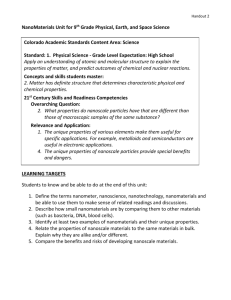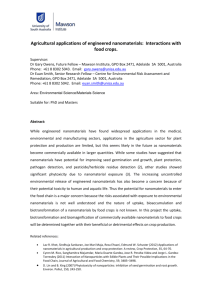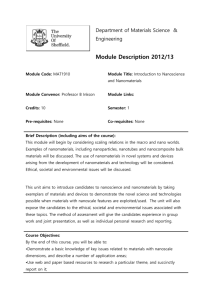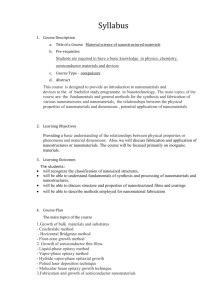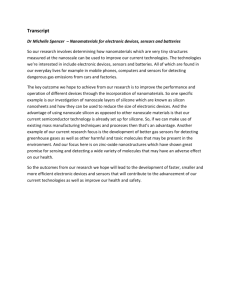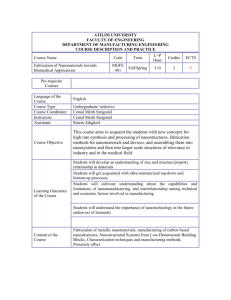Proposed Regulatory Framework for Nanomaterials Under the
advertisement
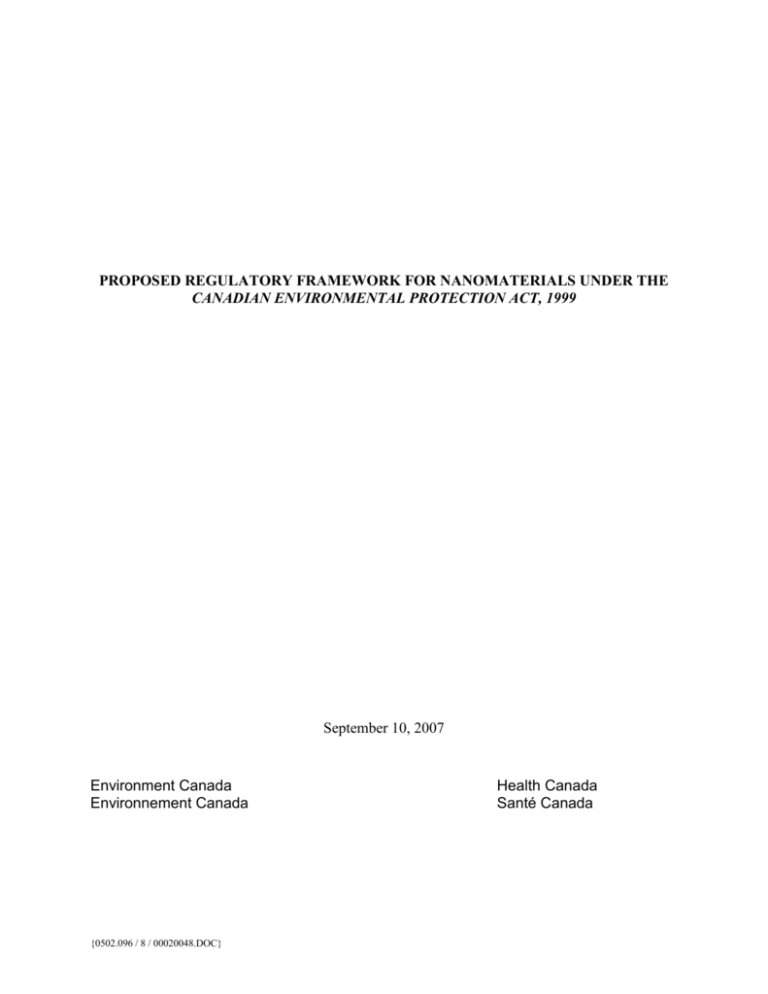
PROPOSED REGULATORY FRAMEWORK FOR NANOMATERIALS UNDER THE
CANADIAN ENVIRONMENTAL PROTECTION ACT, 1999
September 10, 2007
Environment Canada
Environnement Canada
{0502.096 / 8 / 00020048.DOC}
Health Canada
Santé Canada
PROPOSED REGULATORY FRAMEWORK FOR NANOMATERIALS UNDER THE
CANADIAN ENVIRONMENTAL PROTECTION ACT, 1999
INTRODUCTION
Environment Canada and Health Canada have developed a proposal for a regulatory framework
for nanomaterials under the Canadian Environmental Protection Act, 1999. Under the
provisions of this legislation, the Ministers of the Environment and Health are required to
conduct environmental and human health risk assessments and manage appropriately any risks
arising from industrial chemical substances entering the Canadian market. Stakeholders from
industry, non-governmental organizations, and other interested parties are invited to provide
feedback on the proposed approach to developing a regulatory framework as well as to consider
the options for gathering information on industrial nanomaterials as a part of the first phase.
Nanotechnology is a rapidly emerging field described generally as the control and structuring of
matter at dimensions typically between 1 and 100 nanometres to create materials, devices, and
systems with fundamentally new properties and functions. Nanoscale chemical substances, or
nanomaterials, behave differently from their macroscale counterparts, exhibiting different
mechanical, optical, magnetic, and electronic properties. As a result of such novel properties,
nanomaterials are anticipated to have applications addressing a wide range of issues including
health and the environment. The novel properties of nanomaterials, however, may also give rise
to new exposures and effects which need to be assessed for their potential impacts on human
health and the environment. It is incumbent on Environment Canada and Health Canada to
develop a regulatory framework under the Canadian Environmental Protection Act, 1999 which
enables the responsible introduction of nanomaterials to Canada through the scientific
assessment and appropriate management of the potential risks.
The proposal for the development of a responsible regulatory framework under the Canadian
Environmental Protection Act, 1999 consists of two phases as international and domestic
activities progress. Canada is involved with the activities of the Organization for Economic Cooperation and Development and the International Organization for Standardization. The federal
Science & Technology community is coordinating efforts within the government of Canada to
address regulatory science issues. These activities will inform the development of a regulatory
framework in a progressive manner which builds a foundation of knowledge through
collaboration with industry and the public.
This document provides background information on nanomaterials and the Canadian
Environmental Protection Act, 1999 as well as information on the proposal for developing an
effective regulatory framework for nanomaterials. The following sections contain:
A brief overview of the science and impacts of nanomaterials;
The role of the New Substances Program in conducting risk assessments;
The proposed approach for a regulatory framework for nanomaterials under the Canadian
Environmental Protection Act, 1999;
Options for information gathering initiatives; and
Path forward for Government and stakeholders.
{0502.096 / 8 / 00020048.DOC}
2
BACKGROUND
BASIC SCIENCE OF NANOMATERIALS
The field of nanotechnology finds its roots in physics, chemistry, biology, and engineering and is
described generally as the manipulation of matter at the scale of typically 1 to 100 nanometres to
create new and innovative materials, devices, and systems. One nanometre is equal to one
billionth of a metre. By comparison, the diameter of human hair is about 100,000 nm and a red
blood cell measures approximately 10,000 nm (US EPA, 2007). At these dimensions, chemical
substances exhibit properties different from their macroscale counterparts. For example, nanogold exhibits dramatic changes in properties and colour with only slight changes in size (Science
Daily, 2004).
Nanomaterials can also be formed at the nanoscale in either 1 dimension (chips, sheets), 2
dimensions (tubes, rods) or 3 dimensions (particles, spheres, cubes). The properties observed in
nanomaterials are the result of several unique material characteristics, including confinement and
high surface area. Confinement occurs in the formation of a metallic nano lattice structure where
the atoms are squeezed much closer together than one would observe in a standard bulk metal
lattice. In this state of confinement, the atoms strain against forces of repulsion and generate
some of the unique properties that we observe in metallic nanomaterials. Concerning high
surface area, we are familiar with the high surface area in the context of activated charcoal and
its ability to absorb contaminants. Nanoparticles, such as nanotubes, and metal oxides likely
have substantially higher surface areas than their counterparts, and this feature also induces
different material behaviours.
The changes in the mechanical, optical, magnetic, and electronic properties of nanoscale
chemical substance, or nanomaterials, give rise to their potential use in a broad range of
applications including those which can address human health and environmental issues. For
example, iron nanoparticles are being studied for use in contaminated site remediation as a more
effective and efficient scavenger of contaminants due to an increased number of reactive sites
relative to the size and volume of the nanoparticles (Varanasi, Fullana, & Sidhu, 2007). Nanosilver particles exhibit anti-bacterial properties and are being blended in household paints which
are available in the consumer market (Nano Acceleration Network, 2006).
IMPACTS OF NANOMATERIALS
By the year 2015, an estimated $1 trillion worth of products worldwide will incorporate
nanotechnology (Roco and Bainbridge, 2001). Some nanomaterials are currently in use with
many consumer products available which utilize nanotechnology or nanomaterials in some
manner (Woodrow Wilson International Center for Scholars, 2007). The Canadian market for
nanotechnology is increasing with more funds being directed towards research and development
(Canadian Broadcasting Corporation, 2007).
While the novel properties of nanomaterials may lead to new innovations, these same properties
may give rise to new risks. For example, the physical size of nanomaterials may facilitate entry
{0502.096 / 8 / 00020048.DOC}
3
into the body of organisms and the crossing of cellular membranes. The high surface area to
volume ratio of nanomaterials can result in a greater number of reactive sites, thus increasing the
potential for interaction with other entities. Additionally, the electronic properties of
nanomaterials may interfere with normal cell function. There is, however, a limited
understanding of the potential impacts and further research is needed.
In order to regulate nanomaterials effectively, a better understanding is needed of the properties,
behaviour, and effects of nanomaterials. Environment Canada and Health Canada are proposing
an approach to the development of a regulatory framework under the mandate of the Canadian
Environmental Protection Act, 1999 to address nanomaterials in a manner which ensures the
responsible introduction of nanomaterials to the Canadian market through a program which
scientifically assesses and appropriately manages any potential risks.
{0502.096 / 8 / 00020048.DOC}
4
CEPA 1999 AND THE NEW SUBSTANCES PROGRAM
The Canadian Environmental Protection Act, 1999 (CEPA 1999) is in place to contribute to
sustainable development through pollution prevention and the protection of the environment and
human health. Part 5 of CEPA 1999 establishes a legal regime for the assessment and
management of chemicals and polymers which includes provisions for new and existing
substances as well as information gathering and assessment powers. Under the provisions of
CEPA 1999, the Ministers of the Environment and Health are required to conduct environmental
and human health risk assessments and manage appropriately any risks arising from chemical
substances entering the Canadian market.
The scope of CEPA 1999 includes the risk assessment and risk management of new and existing
commercial and industrial substances. Other applications of nanomaterials, such as pesticides
and pharmaceuticals, are addressed under other appropriate legislation (e.g., Pest Control
Products Act, Food and Drugs Act). The Food and Drugs Act, however, does not provide the
authority for addressing potential environmental and human health impacts from environmental
exposure to substances and CEPA 1999 is used to address this regulatory oversight.
The New Substances Program is responsible for conducting risk assessments and administering
appropriate risk management, when necessary, of chemical substances under the authority of the
New Substances Notification Regulations (Chemicals and Polymers) (NSNR). Prior to a
chemical substance being introduced to the Canadian market, companies are required to submit a
notification to Environment Canada and Health Canada following prescribed information
requirements under the NSNR.
Under the current regulatory framework, an “existing” substance is any chemical or polymer
listed on the Domestic Substances List (DSL). The DSL is a compilation of all known
substances that were in Canadian commerce between 1984 and 1986 or that are added to the
DSL in accordance with CEPA 1999. A “new” chemical substance is any substance not listed on
the DSL and is subject to notification to the government for assessment. The New Substances
Notification Regulations (Chemicals and Polymers) (NSNR), specify the information to be
submitted if a new substance is intended for import to or manufacture in Canada. (Environment
Canada, 2007a).
At present, there is no definitive system of nomenclature for nanomaterials; however, over the
next year Canada will be working with other countries under the auspices of the International
Organization for Standardization (ISO) to develop a nomenclature system specific to
nanomaterials. Once in place, this nomenclature system will simplify the task of determining
whether a particular nanomaterial is new or existing under CEPA 1999.
Until a nomenclature system is established, Canada has issued an advisory note describing new
and existing nanomaterials under the current regulations (See Appendix A, Environment Canada,
2007b). Substances listed on the DSL whose nanoscale forms do not have unique structures or
molecular arrangements are considered “existing”. The nanoscale form of a substance on the
DSL is considered a “new” substance if it has unique structures or molecular arrangements.
{0502.096 / 8 / 00020048.DOC}
5
Nanomaterials present challenges to the current regulatory framework under CEPA 1999
because their novel properties may give rise to new effects and behaviours which may lead to
impacts on human health and the environment. The current data requirements for “traditional”
chemicals and polymers may not be appropriate to permit adequate risk assessments of
nanomaterials. Therefore, Environment Canada and Health Canada are proposing an approach
for the development of a regulatory framework for nanomaterials under CEPA 1999.
{0502.096 / 8 / 00020048.DOC}
6
PROPOSED APPROACH FOR A REGULATORY FRAMEWORK FOR
NANOMATERIALS
A regulatory framework for nanomaterials needs to be developed in a way that is scientifically
robust and harmonizes with the outcomes of international efforts. Environment Canada and
Health Canada are proposing the development of a regulatory framework for nanomaterials
consisting of two phases of implementation based on shorter and longer term objectives.
Phase 1 (started fall 2006)
a. Continue work with international partners to develop scientific and research
capacities (OECD, ISO).
b. Inform potential notifiers of their regulatory responsibilities under the current
framework.
c. Develop initiatives to gather information from industry on the uses, properties, and
effects of nanomaterials.
d. Consider whether amendments to CEPA 1999 or the NSNR would be needed to
facilitate the risk assessment and management of nanomaterials.
Phase 2 (starting 2008)
a. Resolution of terminology and nomenclature by ISO TC229.
b. Consider establishing data requirements under the NSNR specific to nanomaterials.
c. Consider the use of the Significant New Activity (SNAc) provision of CEPA 1999 to
require notification of nanoscale forms of substances already on the DSL.
Phase 1a: Work with International Partners
The importance of a responsible regulatory framework is recognized not only in Canada but also
in the international regulatory community. Efforts have been initiated to ensure coordination and
encourage collaboration on the underpinning scientific issues which will meet the needs of all
regulatory programs. International efforts towards understanding the properties, effects, and
behaviours of nanomaterials are being led primarily by the Organization for Economic Cooperation and Development (OECD) and the International Organization for Standardization
(ISO). (See Appendix B for more information). Canada is in a position to inform the
development of a domestic regulatory framework by drawing on the experiences and expertise of
other countries.
Phase 1b: Communication with Industry and the Public
The New Substances Program is preparing communication materials to inform industry and the
general public of nanotechnology and nanomaterials issues including information gathering
initiatives and regulatory responsibilities under CEPA 1999 for manufactured or imported
nanomaterials. Communication will be in the form of advisory notes, factsheets, web postings,
public presentations, and multi-stakeholder meetings. Environment Canada is also working with
Industry Canada on several projects to develop lists of potential nanotechnology related firms
and associations in Canada
{0502.096 / 8 / 00020048.DOC}
7
Phase 1c: Information Gathering Initiatives
The purpose of information gathering initiatives is to promote the submission of data from
industry to regulatory programs in order to inform the development of effective regulatory
frameworks. Due to limited information on use patterns, effects, and behaviour of
nanomaterials, governments worldwide are implementing both voluntary and mandatory
schemes to obtain data from industry and build a foundation of knowledge on nanomaterials.
Environment Canada and Health Canada are examining a number of options toward the
development of an effective information gathering program. See the section below on
information gathering initiatives for more details on the proposed initiatives.
Phase 1d: Legislative Amendments
Since the current regulatory framework for new substances does not address nanomaterials
specifically, amendments to CEPA 1999 and the NSNR may be considered in order to
accommodate any necessary requirements to ensure risk assessment and risk management can be
conducted effectively. Changes to CEPA 1999 may address emerging technologies, such as
nanotechnology, by providing the authority to require the notification and assessment of
substances associated with those emerging technologies, in a manner similar to the New
Substances provisions of CEPA 1999. Another possible amendment would be to the definition
of “substance” under section 3 of CEPA 1999 to more clearly include nanomaterials.
Phase 2a: Terminology and Nomenclature
Through the efforts of the ISO TC229, establishment of standard terminology and a standard
nomenclature system is targeted for the end of 2008. Resolution of this matter will benefit
regulatory programs by allowing for unique descriptors allowing nanomaterials to be
distinguished from one another. This would simplify the use of regulatory instruments such as
the Domestic Substances List, Significant New Activity notices, and Ministerial Conditions.
Phase 2b: Data Requirements for Nanomaterials
Amendments to the NSNR may be needed to prescribe data requirements specific to
nanomaterials. The current range of data requirements for chemicals and polymers may not be
suitable for nanomaterials and other endpoints may need to be considered (e.g., agglomeration,
surface functionalization). Furthermore, current test methods may need to be modified and new
test methods may need to be developed to accommodate nanomaterials. Various technical
groups, including within the OECD and ISO, are examining the applicability of current test
methods to nanomaterials.
Phase 2c: Significant New Activity (SNAc)
A Significant New Activity (SNAc) Notice is a notice describing, by inclusion or exclusion, a
significant new activity that results or may result in:
{0502.096 / 8 / 00020048.DOC}
8
a significantly greater quantity or concentration of the substance in the environment; or
a significantly different manner or circumstances of exposure to the substance.
A SNAc Notice may be issued for a substance if there is a suspicion that a significant new
activity in relation to the substance may result in the substance becoming “toxic” under CEPA
1999 (Environment Canada, 2007c).
For substances which are already in commerce, if there is a suspicion that the nanoscale form
may pose a risk, Environment Canada and Health Canada can deem the nanoscale form of an
existing substance as a significant new activity. The SNAc provision could be used to compel
notification of the nanomaterial.
{0502.096 / 8 / 00020048.DOC}
9
INFORMATION GATHERING INITIATIVES
Many countries have implemented or plan to implement information gathering schemes to obtain
basic knowledge ranging from use patterns to effects data. The information gathered through
these initiatives is for the purpose of directing the development of regulatory frameworks and the
undertaking of preliminary risk assessments. Environment Canada and Health Canada are
considering two options for obtaining information from industry: a voluntary information
gathering program and a mandatory information gathering program under the authority of CEPA
1999.
Both a voluntary and a mandatory program would target nanomaterials which are deliberately
manufactured or engineered. The types of information requested would include substance
identification; use patterns, including applications and quantities of use; physical-chemical
properties; fate and behaviour data, and health and environmental effects. Furthermore,
information on natural nanomaterials, incidental nanomaterial by-products, and nanomaterials in
research and development would also be informative.
Companies or parties who manufacture, import, process, or use nanomaterials will be asked to
submit available information on those substances. The type of information that could be sought
under an information gathering initiative may be similar to the current data requirements for
chemicals and polymers under the NSNR. Additional data specific to nanomaterials (e.g.,
agglomeration, surface functionalization) would useful as well.
The US EPA Concept Paper for the Nanoscale Materials Stewardship Program under TSCA (US
EPA, 2007) lists properties specific to nanomaterials. The OECD Working Party on
Manufactured Nanomaterials is also examining properties and endpoints required for safety
testing of nanomaterials.
Information gathered could allow Environment Canada and Health Canada to conduct
preliminary risk assessments, provide insight to the types of information needed to conduct
adequate risk assessments of nanomaterials, and assist in guiding the direction of current
research activities.
VOLUNTARY INFORMATION GATHERING PROGRAM
A voluntary information gathering program is intended to benefit from corporate responsibility
by encouraging industry to submit data on a voluntary basis. A voluntary program is considered
a more informal initiative which can foster collaboration with industry and other parties. Such a
program would provide guidance to industry on the types of information and methods of
submission while also ensuring protection of confidential business information. This type of
information gathering initiative could help build a knowledge base on nanomaterials, encourage
the development of test data, and inform on any necessary risk management.
The information collected from a voluntary program would allow regulatory authorities to
identify Canadian clients and the types of nanomaterials in use in Canada.
{0502.096 / 8 / 00020048.DOC}
10
Nanomaterials which may be of concern for human health or the environment could be identified
as well as the types of data necessary to conduct an informed risk assessment. Further steps
could be taken to encourage the development of test data, the use of risk management practices,
and to continue to promote the responsible introduction of nanomaterials to the Canadian market.
MANDATORY INFORMATION GATHERING
Notices under Section 46 or 71 of CEPA 1999 could be issued to companies making it a
requirement for them to provide the requested information if available. The notices issued are
applicable to those persons (e.g., individuals, companies, institutions, etc.) who are described in
the notice. Response to such notices is mandatory and persons to whom the notice applies, must
make efforts to answer the questions by providing information to which they ought to have
reasonable access. In accordance with Section 313 of CEPA 1999, responding companies may
submit with their information a request that it be treated as confidential. (Environment Canada,
2007d).
Notices issued using either of these provisions under CEPA 1999 would provide a description of
the nanomaterials under investigation as well as the information be submitted.
RESEARCH AND DEVELOPMENT CONSIDERATIONS
Based on current understanding of the nanotechnology market in Canada, it is believed that a
substantive amount of industrial nanomaterials are currently in the research and development
(R&D) stage. Although the current regulatory framework has provisions for R&D substances,
the volume of material required to trigger notification is high relative to quantities employed in
an R&D setting. As a consequence, very few, if any, R&D nanomaterials would be subject to
notification under the NSNR at this time. Nevertheless, the outcomes of research in the areas of
materials science and environment, health and safety (EHS) can be informative to the
development of a responsible regulatory framework.
The scientific research community can play an important role in the early stages of developing a
regulatory framework through participation in information gathering initiatives and linking to
research efforts by the OECD and the federal government. Researchers may possess basic
information on nanomaterials (e.g., physico-chemical properties) or laboratories may have the
capacity to generate data which can inform risk assessment and risk management.
{0502.096 / 8 / 00020048.DOC}
11
PATH FORWARD
Nanomaterials are predicted to become significant in future commercial markets and beneficial
innovations to health and environmental applications are anticipated; however, the potential risks
arising from the novel properties of nanomaterials need to be addressed in a scientifically
responsible manner. The development of an effective regulatory framework for nanomaterials in
Canada will make use of the outcomes of international efforts and collaboration with industry.
Information gathering initiatives will be developed in conjunction with industry and the public
through multi-stakeholder consultations. This will be the first substantive step toward enabling
the appropriate risk assessment and risk management of nanomaterials.
This multi-stakeholder consultation intends to obtain feedback and opinions on:
Environment Canada and Health Canada’s approach to the development of a regulatory
framework for nanomaterials under the Canadian Environmental Protection Act, 1999
The most effective approach to gather information on nanomaterials quickly and
efficiently to inform the development of a regulatory framework.
Future consultations may be held on other aspects of the Environment Canada and Health
Canada’s approach to regulating nanomaterials in Canada in order to ensure that the needs of
both industry and the public are met through an open and transparent process.
Stakeholders are invited to provide written comments on the proposed regulatory framework and
the options for information gathering to the following address:
Bernard Madé
Director, New Substances Division
Environment Canada
351 St. Joseph Blvd, 14th floor
Gatineau, QC
K1A 0H3
Bernard.Made@ec.gc.ca
{0502.096 / 8 / 00020048.DOC}
12
REFERENCES
Canadian Broadcasting Corporation. (2007). Alberta commits $130M to nanotechnology
research. Retrieved August 21, 2007 from
http://www.cbc.ca/canada/calgary/story/2007/05/03/nano0ab.html
Environment Canada. (2007a). New Substances Web Site.
http://www.ec.gc.ca/substances/nsb/eng/notify_e.shtml
Environment Canada. (2007b). New Substances Program Advisory Note 2007-06 Requirements for nanomaterials under the New Substances Notification Regulations
(Chemicals and Polymers). http://www.ec.gc.ca/substances/nsb/eng/a200706_e.shtml
Environment Canada. (2007c). Guidelines for the Notification and Testing of New Substances:
Chemicals and Polymers. http://www.ec.gc.ca/substances/nsb/cpguide/eng/c9_e.html
Environment Canada. (2007d). Domestic Substances List CEPA Section 71 Notices.
http://www.ec.gc.ca/substances/ese/eng/dsl/notices_avis.cfm
Nano Acceleration Network, 2006. Nano Product: Antibacterial Water-resistant Nanotech Paint
With Silver. Retrieved August 22, 2007 from http://nanotechnology.espaces.com/antibacterial_paint.html
National Research Council Canada. (2007). Groundbreaking Canadian Nanotechnology
Partnership Lays Foundation For Big Success From Tiny Tech. Retrieved August 21,
2007 from http://nint-innt.nrc-cnrc.gc.ca/newsroom/article20_e.html
Roco, M.C., & Bainbridge, W.S. (eds.) (2001). Societal Implications of Nanoscience and
Nanotechnology, NSET Workshop report, March 2001, Virginia; based on National
Science Foundation (NSF) workshop in September 2000, Springer (formerly Kluwer):
Dordrecht.
Science Daily (2004). Nanogold Does Not Glitter, But Its Future Looks Bright. Retrieved July
17, 2007 from http://www.sciencedaily.com/releases/2004/04/040428062059.htm
US EPA. (2007). Concept Paper for the Nanoscale Materials Stewardship Program
under TSCA. Retrieved August 21, 2007 from
http://www.regulations.gov/fdmspublic/component/main?main=DocumentDetail&d=EP
A-HQ-OPPT-2004-0122-0058
Varanasi, P., Fullana, A., & Sidhu, S. (2007). Remediation of PCB contaiminated soils using
iron nanoparticles. Chemosphere 66(1031-1038. Retrieved August 22, 2007 from
http://www.sciencedirect.com/science?_ob=ArticleURL&_udi=B6V74-4KV8T751&_user=3297724&_coverDate=01%2F31%2F2007&_rdoc=1&_fmt=&_orig=search&_
sort=d&view=c&_acct=C000058537&_version=1&_urlVersion=0&_userid=3297724&
md5=633c21edea565333ac0cd79c19520ed0
{0502.096 / 8 / 00020048.DOC}
13
Woodrow Wilson International Center for Scholars. (2007). Nanotechnology Consumer
Products Inventory. Washington D.C.. Retrieved July 17, 2007 from
http://www.nanotechproject.org/44/consumer-nanotechnology
{0502.096 / 8 / 00020048.DOC}
14
APPENDIX A
The New Substances Program Advisory Note 2007-06 can also be found at
http://www.ec.gc.ca/substances/nsb/eng/a200706_e.shtml.
New Substances Program Advisory Note 2007-06
Requirements for nanomaterials under the New Substances Notification Regulations
(Chemicals and Polymers)
This advisory note is to inform manufacturers and importers of nanomaterials and any other
stakeholders of the requirements for the substances under the New Substances Notification
Regulations (Chemicals and Polymers).
Background
Under the provisions of the Canadian Environmental Protection Act, 1999 (the Act), the New Substances
Notification Regulations (Chemicals and Polymers) [the Regulations] ensures that any new substance
(whether a chemical or polymer) undergoes a risk assessment of its potential effects on the environment
and human health.
If you manufacture in or import into Canada a new substance, you may be required to notify information
with respect to this substance pursuant to the Act and the Regulations. The Act requires that the
prescribed information under the Regulations be submitted to the Minister of the Environment prior to
exceeding specific regulatory triggers either through the manufacture or import of a new substance.
The Domestic Substances List (DSL) is the sole basis for determining whether a substance is new. Any
chemical or polymer not listed on the DSL is considered to be new to Canada and is subject to the
notification requirements under the Regulations. Substances listed on the DSL do not require notification1
in advance of manufacture in or import into Canada.
The Act and the Regulations apply to new nanomaterials just as any other substance, whether a chemical
or a polymer.
What is considered a nanomaterial?
Although there is no internationally recognized definition of this type of substance, nanomaterials can be
described generally as substances having one or more dimensions in a nanoscale range, typically2
between 1-100 nanometers.
Canada is collaborating with international partners through the International Organization for
Standardization (ISO) to develop standard terminology and a formal nomenclature system for
nanomaterials.
What are the requirements under the Regulations for nanomaterials which are
manufactured or imported?
Nanomaterials which are manufactured3 in or imported into Canada are subject to the same regulatory
requirements as chemicals and polymers, and notifiers must submit a New Substances Notification
{0502.096 / 8 / 00020048.DOC}
15
package prior to the manufacture in or import into Canada of the new substance (refer to Guidelines for
the Notification and testing of New Substances: Chemicals and Polymers, Version 2005).
Although not required, Environment Canada and Health Canada recommend notifiers request a Prenotification Consultation (PNC) during the planning or preparation of a notification. For example, a notifier
can request a PNC to assist with determining whether the substance is notifiable, as well as to clarify
notification procedures or information requirements, and to determine the acceptability of waiver requests
and/or test protocols.
What nanomaterials are subject to the Regulations?
Nanomaterials which are manufactured in or imported into Canada that are not listed on the DSL are
considered new. The nanoscale form of a substance on the DSL is considered a "new" substance if it has
unique structures or molecular arrangements. New nanomaterials are subject to notification under the
Regulations. For example, the nanomaterial fullerene (CAS No. 99685-96-8) is not listed on the DSL and
is considered a "new" substance under the Regulations.
What nanomaterials are not subject to the Regulations?
Substances listed on the DSL whose nanoscale forms do not have unique structures or molecular
arrangements are considered existing. Existing nanomaterials are not subject to the Regulations and do
not require notification. For example, titanium dioxide (CAS No. 13463-67-7) is listed on the DSL and
since its nanoscale form does not have unique structures or molecular arrangements, it is not subject to
the Regulations.
In addition, incidentally produced or naturally occurring nanomaterials are not subject to notification.
Contact Information
New Substances Notification Information Line
Telephone:
1-800-567-1999 (toll-free in Canada)
1-819-953-7156 (outside Canada)
Facsimile: 1-819-953-7155
E-mail: nsn-infoline@ec.gc.ca
For additional information or documentation regarding the Regulations, please visit the New Substances
Web site at www.ec.gc.ca/substances/nsb/eng/home_e.shtml.
Original signed by
Bernard Madé
Director
New Substances Division
Environment Canada
Signed on June, 2007
1
Exceptions include those substances listed on the DSL and identified with a) an "S" flag that are
proposed for manufacture or import and used for a significant new activity as defined in the Significant
{0502.096 / 8 / 00020048.DOC}
16
New Activity Notice published for that substance, and b) a "P" flag and where the polymer substance
proposed for manufacture or import is in a form that no longer meets the Reduced Regulatory
Requirement polymer criteria.
2
Note: certain nanomaterials fall outside the typical nanoscale range. For example, fullerenes (bucky
balls) have all three dimensions smaller than 1 nanometer, while quantum dots may have all three
dimensions greater than 100 nanometers.
3
Manufactured nanomaterials are purposefully made, in contrast to incidentally produced or naturallyoccurring nanoscale materials. They may be manufactured through chemical and/or physical processes
to create materials with different or enhanced properties and/or structures compared to the macroscale
material.
{0502.096 / 8 / 00020048.DOC}
17
APPENDIX B
OECD Working Party on Manufactured Nanomaterials
The OECD Working Party on Manufactured Nanomaterials was formed in 2006 under the
auspices of the Joint Chemicals Committee and includes representatives from governments,
industry, and non-governmental organizations. The mandate of the Working Party is to
coordinate international efforts on human health and environmental safety aspects of
nanomaterials. Canada has been an active participant since the inception of the Working Party,
playing a key role in the development of the Terms of Reference and the current Programme of
Work (2006-2008).
The Working Party has identified six specific projects on various environmental, health and
safety (EHS) aspects of nanomaterials and has established Steering Groups with country leads to
address each project.
1. Development of an OECD database on EHS research (Australia)
2. EHS research strategies on manufactured nanomaterials (Germany)
3. Safety testing of a representative set of manufactured nanomaterials (United States,
European Commission)
4. Manufactured nanomaterials and test guidelines (United States, European
Commission)
5. Co-operation on voluntary schemes and regulatory programmes (Canada)
6. Co-operation on risk assessment (United Kingdom)
The Canadian Head of Delegation to the Working Party resides in the New Substances Division
of Environment Canada and is also responsible for chairing Steering Group 5. Steering Group 5
aims to provide recommendations on effective approaches for information gathering initiatives
and regulatory frameworks. As the chair of Steering Group 5, Canada is afforded a unique
opportunity to inform the development of a domestic regulatory framework by drawing on the
experiences of other countries which have or plan to implement various information gathering
schemes.
ISO Technical Committee 229
Technical Committee 229 (TC 229) of ISO was formed in 2005 to address standardization in the
field of nanotechnologies. The Canadian federal government is increasing its involvement in the
activities of TC 229 through representatives from the federal Science & Technology community.
Within TC 229, three working groups (WGs) are convened by different countries to address
specific subject matters.
WG1: Terminology and Nomenclature (Canada)
WG2: Measurement and Characterization (Japan)
WG3: Health, Safety and Environment (United States)
{0502.096 / 8 / 00020048.DOC}
18
Standard terminology and a standard nomenclature system are essential for the development of
an effective regulatory framework. Precise identification of nanomaterials is needed in order to
determine the appropriate regulatory track and ensure any appropriate risk management.
{0502.096 / 8 / 00020048.DOC}
19
ACKNOWLEDGEMENTS
Environment Canada and Health Canada would like to acknowledge the following people for
their valuable insight and contributions to this document:
Michelle Lee
New Chemicals Evaluation
Environment Canada
Bernard Madé
New Substances Division
Environment Canada
Andy Atkinson
New Chemicals Evaluation
Environment Canada
Jonathan Tigner
New Chemicals Evaluation
Environment Canada
Doug Green
New Substances Assessment and Control
Bureau
Health Canada
Shaunalea Savard
New Substances Assessment and Control
Bureau
Health Canada
Linda Prang
ON Environmental Protection Operations
Environment Canada
Kyra Schitka
ON Environmental Protection Operations
Environment Canada
Gail Bonnell
Program Innovation and Coordination
Environment Canada
Karen Mailhiot
Notifications and Client Services
Environment Canada
Joanne Papineau
Notifications and Client Services
Environment Canada
{0502.096 / 8 / 00020048.DOC}
20

